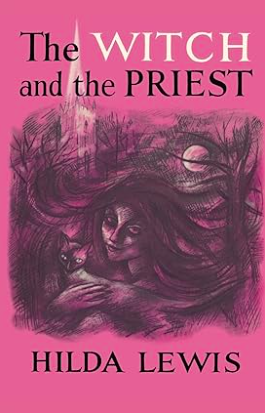
If you like “authentic” representations of the occult in fiction and film, then you’ll appreciate Hilda Lewis’ The Witch and the Priest (1956). The novel falters with a clumsy framing device and a writing style that’s too minimalist for the time and subject. Still, these missteps are more than balanced by a careful attention to historical detail and a shape-shifting devil, who is at once seductive and unnerving.
The elderly Reverend Samuel Fleming can’t stop thinking about Joan Flower and her two daughters, Margaret and Philippa. As magistrate, Fleming played a pivotal role in their terrible fate–Joan was mysteriously struck dead while answering to charges of witchcraft, while Meg and Philippa were hanged for their dalliances with the Devil. Now he is haunted by the possibility that they were innocent; and if they were guilty, then why didn’t he, as their Priest and spiritual shephard, guard them from Satan’s snares? The insistence of his questioning calls forth the ghost of Joan Flower, who, rejected by both God and the Devil, exists in a state of limbo between heaven and hell. She has come to tell her story and to offer Fleming another chance to save her soul. If he doesn’t succeed this time, his own salvation may be in danger.
Lewis has done her research on the witchcraft trials of the sixteenth and seventeenth centuries; and her characters bring the dusty details of archival testimony to life. Fictionalized from real historical records, Joan’s confession to Fleming foregrounds the utter strangeness of contemporary beliefs about witchcraft, illuminating the fantasies and anxieties of the time. In her discussion with the Priest, we learn the stages of spellcasting, the order of meetings, and the recipe for flying ointment, an awful unguent made with the fat of infants. She describes the elements of the Sabbath, expanding in particular on a ritual called “The Kiss of Adoration,” during which acolytes pay homage to the devil by pressing their lips to his ass. This isn’t as crude as it sounds because, in a convenient perversion of goat anatomy, the Horned God has a second face below his tail. The novel is full of outlandish anecdotes like this, and my time as a reader was amply rewarded with the endless rich and curious particulars of occult lore.
While many of Joan’s accounts (like the one above) are humorous, others remind us of why people feared the Devil; and these dark yarns shift what would otherwise be straightforward historical fiction into the realm of horror. Lewis’ first description of the Devil is masterful and chilling: Manifesting in Joan’s tiny cabin, he is an impossibly large figure, who must bend and tilt to fit beneath her ceiling. The fluidity of his form is disturbing. Depending on the context, the Devil appears as a handsome man with horns, a boy dressed in green, or a magnificent ram. He may speak smoothly like a flirtatious gentleman or use a child’s voice to condemn the unfaithful. What’s most unsettling about Lewis’ Satan is that he collapses the comforting space between the domestic and the transcendent: He’s a God in a dirty kitchen at mid-day. And the only thing standing between him and the outside world–concealing him from neighboring gossips–is a rag of homespun hastily hung over the window. In Joan’s world, the Devil is as close as the house next door and might be hidden by a threadbare dishcloth. Deftly presenting these precarious situations, Lewis explores the delicate nature of safety and upsets the reader’s sense of security.
The Witch and the Priest is at its best when Joan describes her encounters with Satan and the coven. Unfortunately, her stories are repeatedly interrupted by the novel’s framing device: God is giving Fleming one more chance to save Joan’s soul; In order for the Priest to be victorious, he must understand the circumstances and motivations that led her to the Devil. Thus we have her account. More appropriate for a child’s lesson, this silly conceit of a spiritual contest is too weak to support the weight of Joan’s accusations as she charges the pious community with misogyny, hypocrisy, and cruelty. And lest you forget about the framing device, there are reminders at least once per chapter. Why, the Priest asks, is he suffering through lurid tales of sex and infanticide? Ah, yes, it’s because he’s in the midst of a battle for redemption.
These repeated explanations diminished my enjoyment of the novel and so too did its language. Lewis writes in a clear and concise style. And while this style isn’t appropriate for 17th-century characters, it does make their thoughts and feelings readily accessible to a modern audience. In general, I agree with this aesthetic approach because the primary goal of a novel like this is to entertain. Still, I think that some linguistic opacity is worthwhile, not because it gestures toward “authenticity”–this isn’t an academic exercise–but because it foregrounds the essential foreignness of the past. And that irreducible difference is a little scary. If you’ve seen Robert Eggers The Witch (2015), then you know what I’m talking about. For the first 5 minutes of that film, I struggled to find meaning in the characters’ dialogue and wondered if they were even speaking English. Of course, they are; but the resistance of their speech to modern understanding intensifies the unassimilable particularity and weird atmosphere of the represented historical moment. It creates dark weeds of psychological dread, the kind that can’t creep and twist in the clear space of Lewis’ sentences.
Despite these shortcomings in style and structure, The Witch and The Priest is worth reading for its granular focus on occult practices and memorable representations of the Devil. For an especially witchy weekend, pair it with Eggers’ masterpiece, settle in with your favorite familiar, and enjoy!